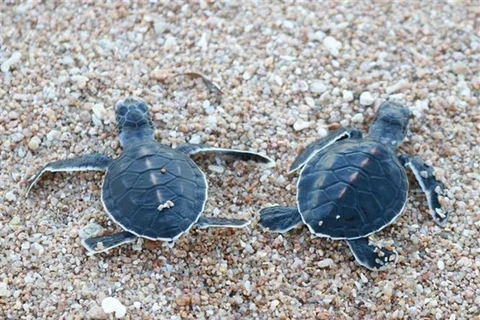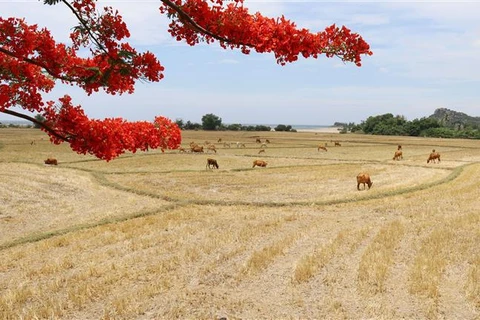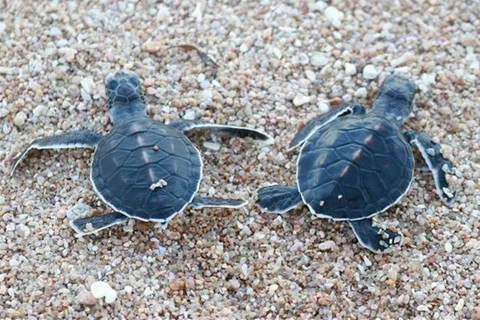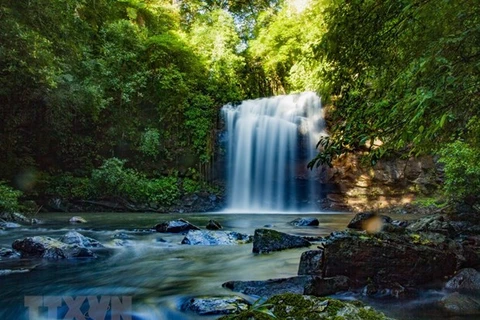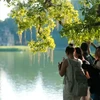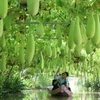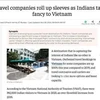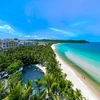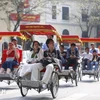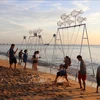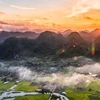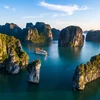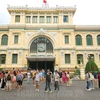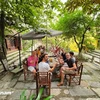 The wild beauty of Hang Rai tourist spot in the tourist complex of Nui Chua Biosphere Reserve (Photo: VNA)
The wild beauty of Hang Rai tourist spot in the tourist complex of Nui Chua Biosphere Reserve (Photo: VNA) Hanoi (VNA) - Two Vietnamese sites – Kon Ha Nung Plateau in the Central Highlands province of Gia Lai and Nui Chua Biosphere Reserve in the central province of Ninh Thuan - were recognised as new world biosphere reserves by UNESCO at the 33rd session of its International Coordinating Council of the Man and the Biosphere Programme (MAB-ICC) in Nigeria from September 13-17.
The two new sites take the number of global biosphere reserves in Vietnam to 11, ranking it the second in Southeast Asia, only after Indonesia with 19.
Nui Chua Biosphere Reserve
The 106.6-ha Nui Chua Biosphere Reserve encompasses the terrestrial and marine areas of Ninh Thuan and is located at the end of the Truong Son Mountain Range where the climate is harsh with sunny, hot and arid weather and minimal rainfall, according to UNESCO.
The biosphere reserve is a representative area in terms of biodiversity with a rich and diverse mosaic of ecosystems characteristic of the south-central region of Vietnam, including unique semi-arid vegetation, sea turtle nesting beaches and coral reefs.
The Nui Chua Biosphere Reserve is endowed with 1,511 species of flora, of which 54 are recorded in the Vietnam Red Data Book and the International Union for Conservation of Nature (IUCN) Red List.
Kon Ha Nung Biosphere Reserve
Covering an area of 413,512ha, the Kon Ha Nung Biosphere Reserve includes two core zones of Kon Ka Kinh National Park and Kon Chu Rang natural reserve on 57,493ha, and a 152,693ha buffer zone covering districts and communes of Dak Doa, Mang Yang, Kbang, Chu Pah, Dak Po and An Khe town.
The reserve is home to rare species such as the Gray-shanked douc (Pygathrix cinerea) - a rare and endemic primate species of Vietnam and classified as critically endangered, with only about 1,000 individuals in the wild.
The Kon Ha Nung Biosphere Reserve plays a crucial role in preserving the landscape, ecosystem, species and genetic resources of Gia Lai through many programmes to preserve biodiversity in the two core zones.
Liangbiang Biosphere Reserve
Langbiang is the first World Biosphere Reserve in the Central Highlands that was recognized by UNESCO on June 9, 2015. Langbiang is truly an attractive and special destination for nature lovers.
Located in the north of Lam Dong province, it covers 275,439 hectares of land and boasts a large primeval forest whose core is the Bidoup - Nui Ba National Park. It is assessed as one of the four biodiversity centres in Vietnam.
 The biosphere reserve holds biodiversity values of global importance. Scientists recorded 29 floral species listed in the Vietnam Red Data Book and the International Union for Conservation of Nature (IUCN) Red List. (Photo: VNA)
The biosphere reserve holds biodiversity values of global importance. Scientists recorded 29 floral species listed in the Vietnam Red Data Book and the International Union for Conservation of Nature (IUCN) Red List. (Photo: VNA) Langbiang is home to a great diversity of natural ecosystems, including terrestrial and aquatic ones. It also harbours all the natural forest biotopes which are the habitat for wild animals.
Cu Lao Cham Biosphere Reserve
With diverse flora and fauna and historical relics dating back hundreds years ago, Cu Lao Cham (Cham Island) in the central coastal province of Quang Nam was recognized by UNESCO as a World Biosphere Reserve in 2009.
The cluster of 8 small islands has 1,500ha of tropical forests and 6,700ha of waters.
Mangrove ecosystems in the Cu Lao Cham Biosphere Reserve contribute significantly to coastal protection, climate change resilience, and local economic development.
Mui Ca Mau (Ca Mau Cape) Biosphere Reserve
Cajuput and mangrove forests in the southernmost province of Ca Mau were recognised by UNESCO as a World Biosphere Reserve.
The Ca Mau Cape Biosphere Reserve has main ecological characteristics: primary succession system on alluvial soil, and transition system of typical ecosystems from mangroves to Melaleuca forests in seasonally inundated freshwater flood. It is also a spawning ground of aquatic species.
The biosphere reserve also houses Mui Ca Mau National Park and U Minh Ha National Park, widely known for their peat swamp forests, along with a vast diversity of rare animals and plant species.
Western Nghe An Biosphere Reserve
Located in the central province of Nghe An on the border with Laos, Western Nghe An was recognized as a world biosphere reserve in 2007. Its climate is strongly influenced by a north-east and south-west monsoon.
Covering nearly 1.3 million hectares, it is the largest biosphere reserve in Southeast Asia. Its core zone consists of three nationally protected areas: Pu Mat National Park, Pu Huong Nature Reserve, and Pu Hoat Nature Reserve.
The reserve is home to 130 species of mammals, 295 bird species, 54 species of amphibians and reptiles, 84 species of fish and 39 species of bats.
As many as 70 species of plants and 80 species of animals in the biosphere reserve were listed in the Vietnam Red Data Book, including many rare and endemic species.
Kien Giang Biosphere Reserve
The Kien Giang Biosphere Reserve, which received UNESCO status in 2006, is in the Mekong Delta province of Kien Giang. It comprises 105 islands, the biggest of which is Phu Quoc, a popular tourist hotspot famous for long, sandy beaches and five-star resorts.
The reserve consists of three parts – Phu Quoc National Park, U Minh Thuong National Park and Kien Luong-Kien Hai coastal forest.
Covering an area of over 1.1 million hectares, the biosphere reserve has six ecosystems with 22 different habitat types. It is also home to 1,480 floral species and 860 fauna species.
Red River Delta Biosphere Reserve
The Red River Delta Biosphere Reserve, spanning the three northern provinces of Thai Binh, Nam Dinh and Ninh Binh, got UNESCO recognition in 2004 as a haven for over 200 bird species, including 9 species listed in the International Union for Conservation of Nature (IUCN) Red List.
 The Biosphere Reserve contains geological tectonic activities and biodiversity with outstanding global values. (Photo: VNA)
The Biosphere Reserve contains geological tectonic activities and biodiversity with outstanding global values. (Photo: VNA) The Biosphere Reserve contains geological tectonic activities and biodiversity with outstanding global values. Major habitat types in the area are mudflats, intertidal sandbanks, grasslands, reeds, mangroves and casuarina sand dunes.
It is also home to more than 100 aquatic animal species - around 80 fish and 20 crustacean species.
Cat Ba Biosphere Reserve
The Cat Ba Biosphere Reserve in Hai Phong city’s Cat Ba Island was recognized by UNESCO in 2004.
Covering an area of more than 26,000 ha, the biosphere reserve consists of two core zones that are strictly conserved without human impacts, two buffer zones that allow limited economic development combined with conservation, and two transition zones for economic development.
 Lan Ha Bay in the Cat Ba Biosphere Reserve is one of the attractive tourist destinations for international visitors (Photo: VNA)
Lan Ha Bay in the Cat Ba Biosphere Reserve is one of the attractive tourist destinations for international visitors (Photo: VNA)
There are 2,026 species found in the biosphere reserve including rare ones. Especially, Cat Ba is home to the critically endangered Cat Ba langur, one of the rarest primate species in the world.
Dong Nai Biosphere Reserve
Recognized as a world biosphere reserve by UNESCO in 2001, the Dong Nai Biosphere Reserve is the new name of the former Cat Tien biosphere reserve.
Covering 977,000 hectares in the five provinces of Dong Nai, Binh Duong, Binh Phuoc, Lam Dong, and Dak Nong provinces, the reserve boasts abundant natural resources and biodiversity.
Its core zone includes Cat Tien National Park, Vinh Cuu Nature Reserve, Inland Wetland Protected Area of Tri An- Dong Nai, and Bau Sau Ramsar Site.
The natural environment in the Dong Nai Biosphere Reserve is considered rare and extremely valuable. According to the Vietnam Wildlife Conservation Society (WCS), the biosphere reserve is a place where many natural forests and rare and precious wildlife species of Vietnam and the world are preserved, including elephants, gaurs, sun bears, java rhinos, sorrel roosters.
Can Gio Mangrove Forest Biosphere Reserve
In 2000, the Can Gio Mangrove Forest, or Sac Forest was recognized as a world biosphere reserve. It is the first world biosphere reserve in Vietnam.
The reserve is a population of terrestrial and aquatic fauna and flora, formed in the large delta of the Dong Nai, Sai Gon and Vam Co river mouths.
Covering over 75,000 ha, the reserve is home to 20,000 ha of mangrove forests and the kingdom of over 1,500 wild monkeys, 150 species of plants, 700 species of aquatic invertebrates, 130 fish species, 9 species of amphibians, 44 vertebrates, and 130 species of birds.
Not only being an ideal place for scientific research and eco-tourism, the Can Gio Biosphere Reserve also has great significance for environmental protection./.







